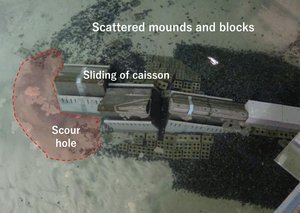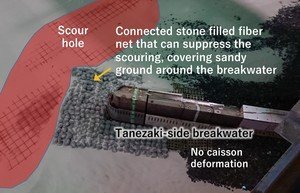Major Research Development of the estimation method for local scour around coastal structures due to tsunami
Concerning methods of designing breakwaters that are tsunami-resistant, several notable design formulas, including the Tanimoto' tsunami pressure formula and the hydrostatic pressure formula during tsunami overflowing were published in the Guidelines on the Tsunami-Resistant Design of Breakwaters in FY2013. However, there are many instances of disasters resulting from scouring caused by tsunami overflowing, as happened at the north breakwater in Hachinohe Port which was devastated by the Great East Japan Earthquake disaster. As little research has been conducted so far on the phenomenon of scouring caused by tsunami overflowing, it is crucial to facilitate studies to accurately estimate the amounts of scouring during tsunami attacks. For this purpose, our study entails hydraulic model experiments to observe scouring caused by tsunami overflowing a breakwater (cross-sectional 2D) as well as scouring that occurs around the head of a breakwater (planar 2D). The design of this experiment involves varying the diameters of the sand particles, etc. and observing the armoring effects that are produced by gravel mounds; we are working to develop a scour estimation method that has high general applicability. In addition, we are exploring other techniques for estimating scouring based on particle methods.
For our FY2020 activities, we studied the armoring effects of gravel mounds and reviewed the performance of scour-prevention mats to minimize scouring caused by tsunami overflowing. We also continued with our study that was started in FY2019 to examine the tsunami-resistance measures that are being implemented on the heads of the breakwaters at the mouth of Urad Bay for their ability to mitigate local scouring.

Movable bed experiment at breakwater head

Scour suppression by installation of bag-style armor blocks



